Authors: Osgur Murphy O Kane, Frank Fu, Yohji Van Weert; Compiled by: Luffy, Foresight News
Key Points
The collapse of FTX and the loss of customer funds have seriously affected the trust of cryptocurrency users in centralized exchanges (CEX). Users are now demanding more transparency and protection measures from the exchanges.
Many exchanges have started to offer proof of asset reserves. Exchanges such as Binance and Bitget have added protection funds. Note that without liability details, these do not guarantee the solvency of the exchanges.
Binance has always maintained a dominant position in the market, but it is not the only beneficiary after FTX’s exit from the market. Following FTX, the trading volume of derivative products of Bitget has significantly increased, while Binance and OKX continue to maintain their advantageous positions in the field of derivative businesses.
After the collapse of FTX, the prices of exchange platform coins MX, BGB, and OKB performed strongly.
In a fiercely competitive environment, successful exchanges will prioritize security, transparency, user trust, and ecosystem construction. At the same time, meeting users’ needs, providing powerful feature sets, and excellent user experience are also important.
Recent CEX Landscape Overview
FTX is a typical representative of CeFi and has been recognized by many celebrities, and even sponsored sports venues. However, behind the scenes, the exchange has been mixing customer funds with its market maker Alameda, resulting in a loss of 4 billion US dollars in customer deposits and ultimately filing for bankruptcy. The FTX incident caused shockwaves throughout the industry, and people’s confidence in centralized exchanges plummeted. This report aims to study the CEX landscape after FTX and the overall trends we see.
Re-focusing on Reputation
The FTX incident seriously damaged users’ trust in CEX. Since then, users have demanded that exchanges increase transparency, with a focus on reserve proofs and protection funds.
Reserve Proof
Many exchanges have started to offer Proof of Reserves (PoR) to address the trust crisis. Reserve proof refers to the act of CEX publicly declaring its reserve assets. This is usually done through independent auditing, with the aim of providing transparent and verifiable evidence that the exchange has sufficient asset reserves to pay customer deposits.
Although this is a step in the right direction, PoR cannot guarantee solvency of an exchange without corresponding liability details. A Proof of Liabilities would be a more convincing way to prove solvency, but it is off-chain and requires independent audit. Furthermore, audits themselves have been proven to be problematic, as FTX underwent an audit before it crashed.
Here is an example of a Binance Reserve Proof on Nansen:

Source: Nansen
Protection Fund
The purpose of the Protection Fund is to provide a cushion for customer assets in case of loss. By establishing a Protection Fund, exchanges aim to make their customers believe that if a hack happens, they will have funds to cover deposits (as long as the fund size is greater than the size of the hack). This scheme can be viewed as excess collateral for customer deposits.
In addition to the Protection Fund, best practices for risk management, such as storing funds in multiple addresses, are crucial for effectively mitigating the impact of various hack attacks. After FTX crashed, Binance increased the USD value of its fund from $735 million to $1 billion. Similarly, Bitget increased its Protection Fund from $200 million to $300 million.
The following table lists the largest exchange Protection Funds in the industry. Note that at the time of writing, Binance and Bitget are the only two centralized exchanges that have publicly disclosed their Protection Fund wallet addresses:
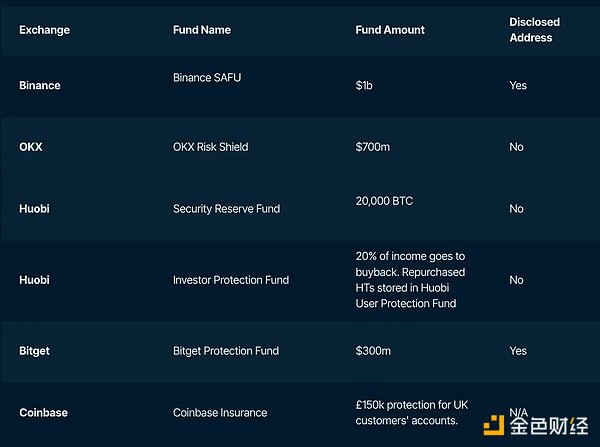
Reserve Proof should become the minimum standard in the exchange industry, but as mentioned above, these positive indicators for exchanges are not enough to guarantee solvency.
CEX Landscape Changes
Total Trading Volume
Binance has maintained a relatively stable trading volume, with an average monthly trading volume of $470 billion in the 6 months prior to FTX’s crash and $428.4 billion in the 5 months after. This means that Binance’s trading volume has decreased by about 10%, but has remained relatively stable. Note that trading volume can be an important metric for measuring exchange performance, but this metric can also be manipulated through wash trading and other means.
The following is the monthly trading volume of 10 selected exchanges in the months following the FTX incident. Note that this does not represent the entire industry, but rather popular, well-known exchanges.
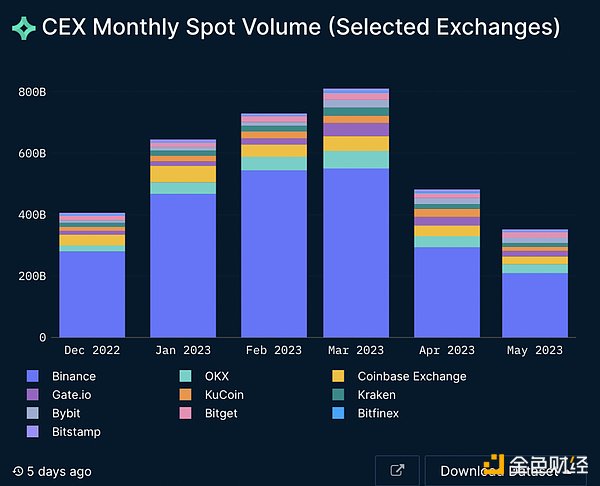
Source: Nansen
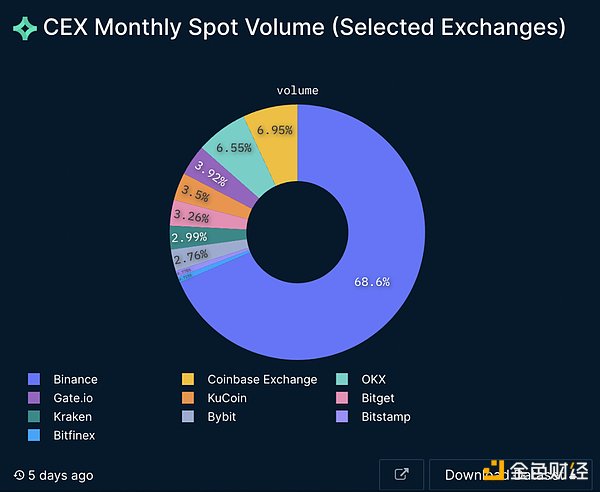
Source: Nansen
Spot Trading Volume
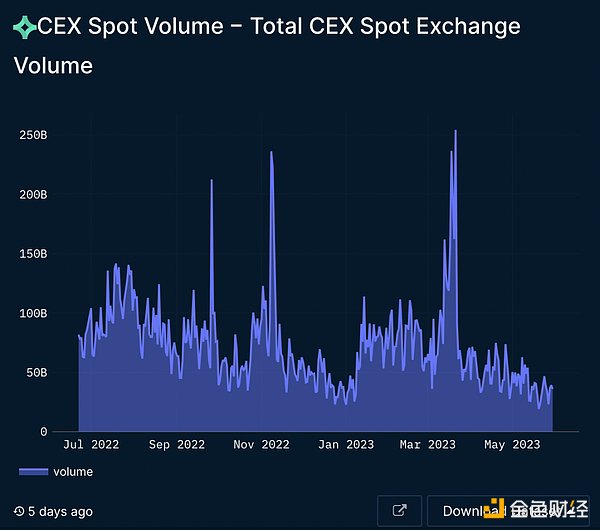
Source: Nansen
The data shows that spot trading volume has slightly decreased in the six months after the FTX crash. The sharp increase in late March can be attributed to the Arbitrum airdrop frenzy. Most exchanges’ spot trading volumes were impacted, with Bybit and Kraken being exceptions as they took measures to increase trading volume.
Meanwhile, DEX trading volume remained relatively stable during the same period. This may be due to the decreased trust in centralized exchanges after the FTX crash and further regulatory uncertainty.
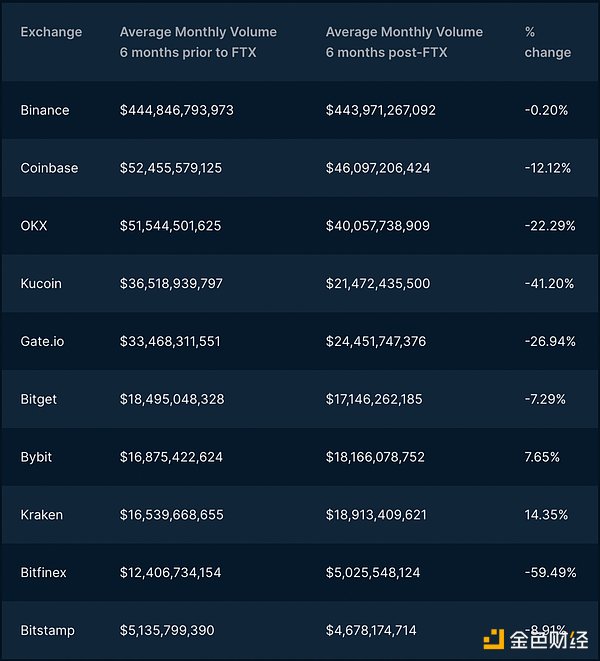
Data as of May 31, 2023
Derivatives Trading Volume
Note that this does not represent the entire industry, but rather some of the popular exchanges among users.
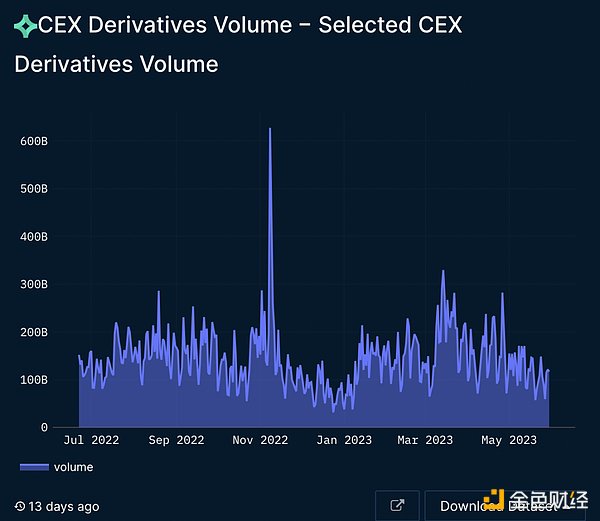
Source: Nansen
Crypto derivatives trading volume showed a small decline. Trading volume surged after the FTX crash in early November and then generally declined. However, since mid-January this year, trading volume has recovered and remained at pre-crash levels.
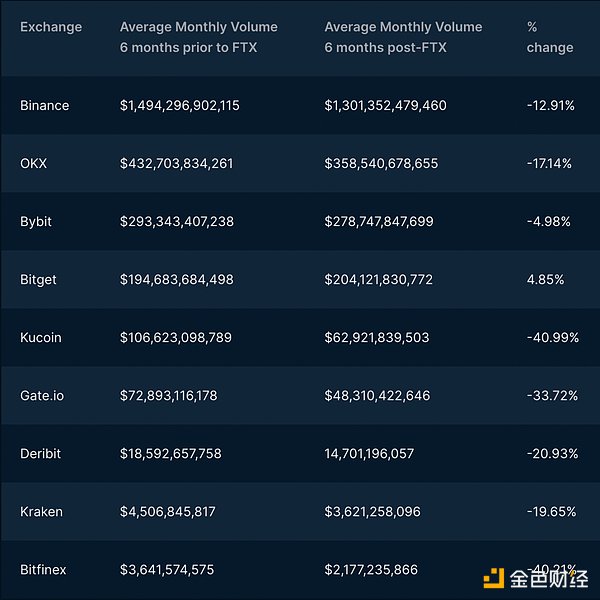
Data as of May 31, 2023
FTX was initially known for its leading derivatives business. Derivatives trading volume has declined among top CEXs, except for Bitget, which saw growth in its derivatives trading volume in the six months after FTX.
Exchanges that performed relatively well in the period after the FTX crash include:
-
Bitget
-
Bybit
-
Binance
Overall, Bitget performed well in its efforts to gain more trading volume. Bybit and Binance saw a small decline, but overall kept most of their trading volume (and expanded their market share), while other exchanges saw larger declines. This may also be due to the trend of decreasing trading activity in the crypto bear market.
Listing Cryptocurrencies
Different exchanges use different listing strategies. For example, Binance only lists projects that have shown significant market hype and trading volume elsewhere. In contrast, Gate.io has taken a more lenient approach and has listed a large number of tokens for initial exchange offerings (IEOs) that have not yet been listed elsewhere.
Since the collapse of FTX, some exchanges have become more sensitive to user demand and market trends. We take BRC-20 as an example, which grew to a market capitalization of $1 billion within three months of its launch.
The first four exchanges to list BRC-20 were Gate, Bitmart, Digfinex, and Bitget.
-
Gate.io: Listed ORDI on May 8
-
Bitmart: Listed ORDI on May 8
-
Digfinex: Listed ORDI on May 9
-
Bitget: Listed ORDI on May 10
Rapidly listing new tokens is key to meeting the constantly changing demands of users, and many traders can benefit from new tokens. However, exchanges must balance the listing of currencies while protecting users from scams. This is important for maintaining the reputation of the exchange, which is why the largest exchanges such as Coinbase, Binance, and Kraken have adopted more conservative listing policies. However, slow listing of tokens may have adverse effects on exchanges, such as missing out on trading volume for popular tokens and recent memecoin trends.
Compliance
Upcoming regulations for DeFi and cryptocurrencies could pose significant challenges for exchanges. SEC Chairman Gary Gensler believes that almost all tokens are securities, which could mean that many exchanges will not be able to operate in the United States. If the US adopts this official position, it could pose serious problems for CEXs globally.
Exchanges also have different requirements for KYC and anti-money laundering measures. These are important for the legitimacy of exchanges and ensuring that they can continue to operate in various jurisdictions. In addition, CEXs found to have inadequate protection measures that facilitate criminal activity will suffer damage to their reputation. An example is zachXBT, who claimed to have registered a Gate.io account under the name “Kim Jong-Un” using an email associated with the North Korean hacker group Lazarus.

Source: Twitter
Platform Tokens
Some exchanges have launched their own platform tokens to incentivize users on their platform. The figure below shows the top 10 platform tokens by market cap and their performance after the FTX crash. MX, BGB, and OKB have performed particularly well, with these three tokens holding strong during the bear market and maintaining levels near their historical highs.
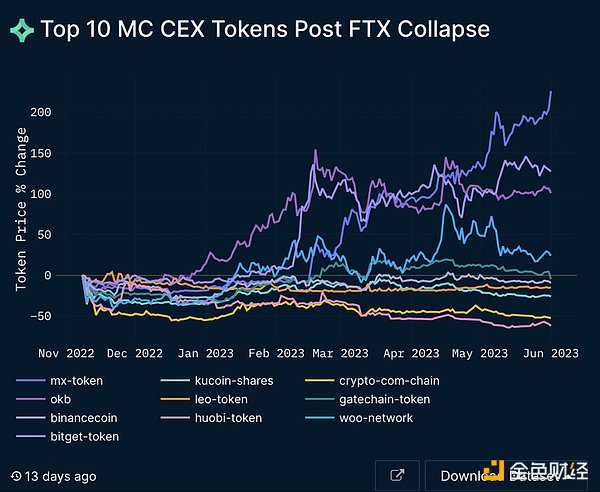
Source: Nansen
MX
MX provides additional utility and earnings for users of the exchange. Additionally, MEXC uses 40% of its profits for quarterly buybacks and burns of MX to keep the token’s circulating supply at 100 million.
BGB
BGB’s utility involves improving Bitget’s user experience by reducing fees, gaining exclusive products, and more. Bitget is expected to roll out a buyback and burn plan for BGB soon. Read more about it here.
OKB
OKB is also a pass to many products and benefits on the platform. It conducts a quarterly buyback and burn based on “seasonal market and operational performance”. In the last report, they bought back and burned OKB worth around $177 million in 3 months.
The impact of buybacks and burns on token price is controversial, with some arguing that they create no value. However, with steady cash flow, the purchasing power of buybacks may contribute to stronger token performance.
BNB
BNB is the largest CEX token by market cap to date. It serves as the Gas token for the BNB Chain and can unlock various features and rights of Binance. BNB has a burning mechanism to maintain a supply of around 100 million tokens, with the amount burned depending on the price of BNB and the number of blocks generated on the BNB Chain in the quarter.
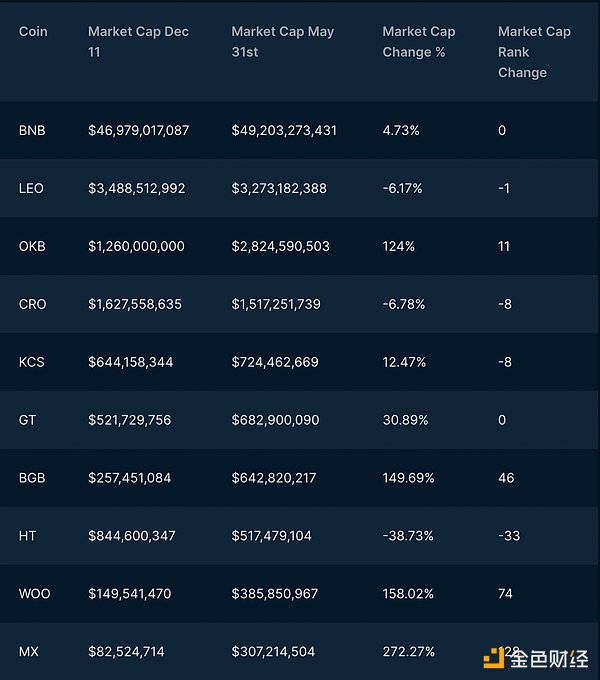
Data as of May 31, 2023
The table above shows the market performance of CEX platform tokens from December of last year to May 31 of this year. MX, WOO, and BGB have performed very well, while HT has experienced the most significant decline.
Performance Records
The performance records of an exchange are crucial to its legitimacy. In fact, most CEXs have experienced hack attacks, some of which have been fatal. Since 2012, losses from hack attacks have exceeded $2.85 billion. No top-tier exchange has been directly hit by a hack since FTX collapsed. However, hack events still occur frequently, including:
-
GDAC was hacked in April 2023, losing $13 million.
-
Bittrue was hacked in April 2023, losing $23 million.
CEXs are still vulnerable to hack attacks, making robust risk management and protection funds more important than ever to ensure that customers don’t suffer losses in unforeseen circumstances.
The Latest Trends in CEXs
CEXs are also increasingly involved in the development of Web3 products. For example, Coinbase not only provides custody wallet services, but also plans to launch L2 (Base) running on the OP stack. Binance has clearly launched the BNB Chain and is very actively investing in a broader ecosystem. Similarly, Bitget has launched MegaSwap, a DeFi aggregator that allows users to conveniently exchange tokens, similar to a typical DEX. In addition, given the huge success of the NFT market in the last bull market, major exchanges such as Binance and Coinbase have launched their own NFT platforms to capture a portion of NFT trading volume and related fees.
Copy Trading
Another popular feature of CEXs is copy trading. It allows users to replicate the strategies of top traders on the platform.
An important difference from on-chain copy trading is that traders need to explicitly authorize the exchange to allow others to copy their trades. In contrast, on-chain copy trading is permissionless, and anyone can copy trading strategies from any address.
Some exchanges that offer copy trading are:
-
Bitget
-
ByBit
-
OKX
-
Gate.io
The aforementioned exchanges offer copy trading services for spot and futures trading.
According to official data, Bitget has over 100,000 copy traders and 490,000 followers using its copy trading feature. Copy traders can earn up to 8% commission by sharing their strategies, and there are specific requirements and application processes.
Bybit has reported that its copy trading feature has been used by 150,000 followers, who can replicate strategies from over 7,000 traders. Copy traders can sort by 7-day win rate, 3-week win rate, and 7-day PnL, and are entitled to 10% of the profits generated by the followers. Various parameters can be customized, including capital size, leverage, stop loss, and other related factors.
On OKX, there are 58 tokens available for copy trading and 1,489 copy traders to choose from. The fee is the same as regular trading fees, and copy traders receive a 10% profit split. Users can copy up to five different traders. The feature offers spread protection and allows for a maximum investment amount to be set. Copy traders can make up to 50 trades per day and can only close positions with market orders.
Gate.io currently has 828 copy traders, who charge 5% of the profits generated by their followers.
Things to consider when copy trading include performance records, performance indicators, trading strategies, risk adjustments, and community participation (follower count). Diversifying the selection of traders to replicate is also considered a good practice to reduce overall portfolio risk.
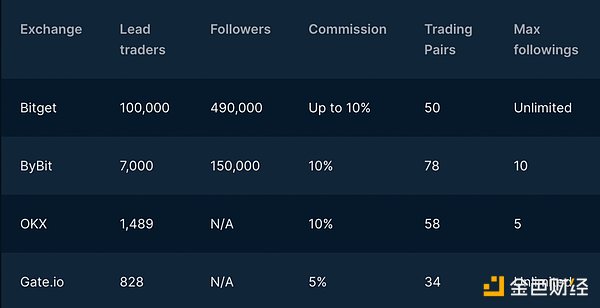
Exchange Ecosystem Business
Many users are increasingly expecting CEXs to participate and contribute to a broader crypto ecosystem.
Coinbase
In February 2023, Coinbase announced the launch of the BASE testnet, which is an Optimistic Rollup built on Ethereum using an OP stack. It aligns with the vision of Superchain, where there will be many interconnected Rollups built using the OP stack. Coinbase has partnered with the Optimism core development team and has committed to decentralizing the sequencer in the future. This seems to indicate progress by Coinbase in the on-chain and broader ecosystem.
Binance
After the FTX crash, Binance deployed a $1 billion “recovery fund” to provide funding for projects that were struggling due to market volatility but were performing well otherwise. As of March, 18 organizations have joined the fund, which has grown to $1.1 billion. This demonstrates the exchange’s commitment and responsibility to the wider industry.
Bitget
In April of this year, Bitget announced a $100 million venture capital fund focused on Asia. It has begun expanding into the crypto ecosystem, acquiring Bitkeep in March 2023. The exchange has also partnered with fetch.ai and CORE DAO to jointly develop its ecosystem.
Who will be the winner?
History tells us that people will not want to “put all their eggs in one basket.” Different exchanges serve different purposes and, depending on the development of global regulation, there may be some large, geographically and legally dispersed exchanges. Exchanges that actively contribute to the ecosystem should be favored and trusted by more users. Most importantly, in addition to a strong set of features and excellent user experience, exchanges need to prove themselves to be safe, transparent, and “trustworthy.” In addition, exchanges need to ensure that their business complies with forthcoming regulations as global regulators seek to implement their digital asset frameworks. This could have a significant impact on the operating models of many exchanges.
Conclusion
The FTX collapse was a catastrophic event for the entire industry, especially for CEXs. This has brought greater challenges to the transparency and depositor protection of CEXs. Since the FTX incident, reserve proof has basically become the industry standard. However, some exchanges are taking further measures, such as protecting funds. Binance and Bitget have increased their protection fund after the collapse of FTX.
Binance has maintained its lead, but it does not monopolize the market left by FTX. We observe that CEX spot trading has decreased relative to DEX spot trading. The trading volume of most derivative trading platforms has fallen, with Bitget being an exception, with a slight increase in trading volume in the months following FTX.
Although exchanges are striving to become more transparent, they still need to adhere to higher standards. Reserve proof and protection funds are improvement measures, but they do not guarantee safety. Successful exchanges need to always provide users with the best features while building trust by increasing transparency, protecting funds, and participating in the ecosystem.
This report was co-authored by Nansen and Bitget.
Like what you're reading? Subscribe to our top stories.
We will continue to update Gambling Chain; if you have any questions or suggestions, please contact us!